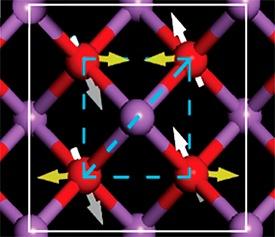

12/27/2010

© 2010 ACS
Superconductors were first discovered almost 100 years ago, but much about the origins of superconductivity itself remain a mystery. It is known that below a critical temperature, superconducting compounds enter a state in which electrons form pairs and the electrical resistance of the material vanishes. In the classical, low-temperature class of superconductors, this pairing is thought to be induced by interactions between electrons and resonant vibrations of the atomic lattice, known as phonons. Such a mechanism, however, is too weak to account for the emergence of pairing at the higher superconducting transition temperatures of the recently discovered class of cuprate and iron-based superconductors.
Mingwei Chen and co-workers from the WPI-AIMR in collaboration with researchers in China1 have now obtained strong evidence that the previously theorized role of spin in phonon–electron interactions is responsible for electron pairing in the high-temperature iron-based superconductor SmFeAsO.
SmFeAsO — an iron arsenide compound called a pnictide — only becomes a superconductor when ‘doped’ with fluorine and cooled to below 55 K. Using a technique known as Raman spectroscopy, which can detect the various types of resonances in an atomic system, Chen and his team looked for differences between doped and undoped SmFeAsO as they varied the temperature. They found that the Raman spectra for the two systems were very similar above 130 K, but below this temperature a new peak emerged only in undoped SmFeAsO. “The new Raman mode is closely correlated with the antiferromagnetic ordering in the material, in which the spins of neighboring atoms are aligned in opposite directions,” says Ling Zhang, who took part in the study.
Indeed, all the pieces fit together: SmFeAsO is known to become antiferromagnetic below 130 K, and the temperature-dependent change in the intensity of this peak can be well described by a model involving a contribution from spin. It is also known that fluorine doping destroys the antiferromagnetic ordering, in good agreement with the observation that the new Raman peak is absent from fluorine-doped SmFeAsO.
To understand the details of the origin of the new Raman peak, Pengfei Guan from the research group calculated the phonon dispersion of the material. His results showed that the unusual mode arose from the formation of a spin superstructure rather than a structural phase transition (Fig. 1).
The importance of the results lies in the solid confirmation of what many theories have hypothesized before. “Our study provides the first clear-cut evidence of spin-dependent electron–phonon coupling in the pnictides,” says Chen.
Zhang, L., Guan, P.F., Feng, D.L., Chen, X.H., Xie, S.S. & Chen, M.W. Spin-dependent electron–phonon interaction in SmFeAsO by low-temperature Raman spectroscopy. Journal of the American Chemical Society 132, 15223–15227 (2010). | article
This research highlight has been approved by the authors of the original article and all information and data contained within has been provided by said authors.